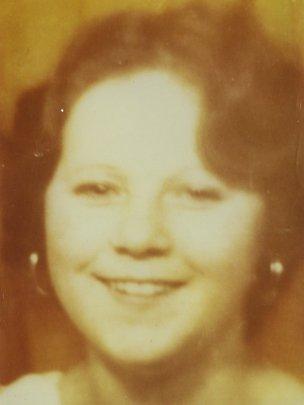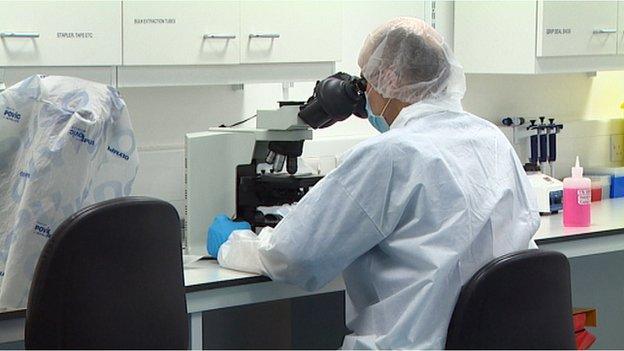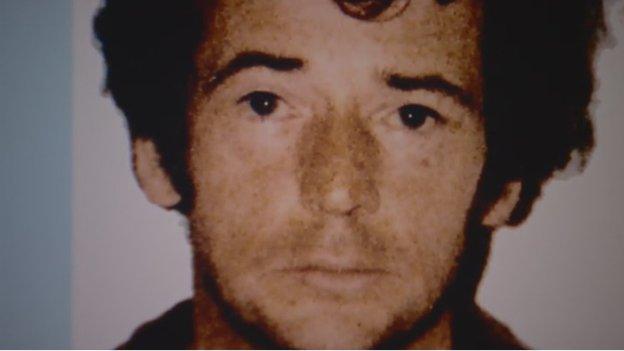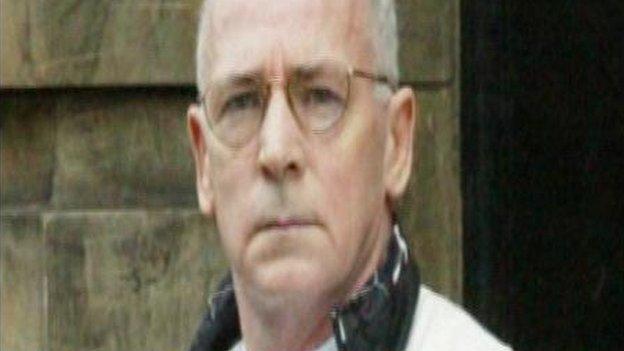World's End murders: Voluntary DNA sample meant Sinclair trapped himself
- Published
"Crimelite" technology allowed DNA stains, previously hidden, to be identified on Helen Scott's clothes
When Angus Sinclair voluntarily gave a DNA sample to police in the mid-1990s, he could never have imagined it would lead to convictions for the murders of three women two decades earlier.
Sinclair was serving a life term in Peterhead Prison for rape and indecent assault of 11 young girls, and in common with all convicted sex offenders, was asked to provide his DNA to help build up the national database.
DNA technology was still then in its infancy and it must have seemed unlikely that it could be used in the investigation of historical crimes.

Sinclair was convicted of murdering Mary Gallacher 22 years after he killed her
What Sinclair did not know was that the operation - code-named Catchem - was designed to do precisely that.
His luck ran out in 2000 when Strathclyde Police carried out a cold case review of the murder and rape of Mary Gallacher in Glasgow which had been unsolved for 22 years.
Database
Detectives had a suspect in their sights - but his DNA did not match samples on the 17-year-old's clothes.
However the database did provide a positive match - Angus Sinclair.
Weeks away from being freed from Peterhead Prison on parole, Sinclair was convicted of murdering and sexually assaulting Mary Gallacher.
Her body was found in bushes in November 1978, with her throat cut and a ligature around her neck.
His conviction provided the impetus for a wider review of cold cases - Operation Trinity led by Deputy Chief Constable Tom Wood of Lothian & Borders Police.

World's End guilty verdict

The clothes of Helen Scott (left) and Christine Eadie yielded DNA which convicted their killer
Police believe Angus Sinclair could be Scotland's worst ever serial killer
The Sinclair trial was the first to be held in Scotland following the ending of the centuries-old double jeopardy rule.
For 37 years the families of Helen Scott and Christine Eadie have waited for justice for the teenagers who were murdered by Sinclair.
Find out more background to the case in a BBC Scotland investigations special. The World's End Murderer programme will be shown on BBC Two Scotland at 22:30 and on the BBC iPlayer.

DNA evidence was key, and it led to Sinclair being charged with the World's End murders of 17-year-old friends Helen Scott and Christine Eadie.
Mr Wood said of Sinclair giving his DNA: "No way will he have known or even have thought that one day that would be his nemesis, that day, that all his debts would come back to haunt him."
He added: "There is no such thing in Scotland as an unsolved murder -- and that's how it should be. And I think that has to be of great comfort to members of the public.
"And I think the message to perpetrators who may think they were involved in something some years ago and have got away with it; perhaps they haven't."
Fast-developing
But sensationally, Sinclair was acquitted in 2007 when the prosecutor in the case at the High court in Edinburgh failed to put key forensic evidence, principally the DNA findings, before the jury - and the judge ruled there was no case to answer.
But the fast-developing science of DNA technology meant a second chance was possible.

Fibres on seats in Angus Sinclair's caravanette were matched by forensic scientists to those found on Helen Scott's coat
It was first used in a Scottish murder case in 1990 - 13 years after the World's End killings.
Crucially police in Edinburgh had kept all of the forensic evidence from that case, allowing scientists to gain further information.
'Truly remarkable'
Retired Detective Superintendent Allan Jones first worked on the case in 1979 - and said the personal connection that officers and scientists felt with it meant they worked hard to see it was finally resolved.
He said: "Unlike many cases I have seen in the past of an historical nature, this was truly remarkable.
"These people had the presence of mind to realise that if they weren't going to solve it at this stage, then science was going to come to the rescue, maybe later on."

DNA recovered from the belt Christine Eadie was wearing proved Sinclair used it to strangle her friend
"The scientists had the presence of mind not to use all of the evidence at once, and to always keep something in abeyance for science to develop to the stage that it has at the moment and that, principally, is what's got us to the position that we are."
In 2011 the Scottish Parliament passed the Double Jeopardy (Scotland) Act, which allowed, for the first time, an accused person to be tried for the second time after acquitted of the same offence.
One of the tests prosecutors had to pass before a case could come back to court, was if new evidence, not available to the original trial, could be put before a jury.
That became a possibility, with the development of a new technique called "crimelite."
Scientists, wearing special viewing goggles, use the LED light, which has filters of different colours, to reveal DNA traces which had previously been almost impossible to detect.
Saliva and semen fluoresce under the light and the crimelite technique revealed Sinclair's DNA was on the ligatures used to strangle and tie up Helen Scott and Christine Eadie - and that he had had sexual intercourse with them.
.jpg)
Crimelite technology located DNA on the bra used as ligature
.jpg)
'Crimelite' technology allowed DNA stains, previously hidden, to be identified on Helen Scott's clothes
The DNA samples were found deep in the knots of the ligatures and had remained hidden from view for more than 30 years until scientists could literally shine a light on the evidence.
'Appalling murders'
It was the breakthrough prosecutors and police needed, and it allowed them to go to court successfully to argue that Scotland's first double jeopardy case should be heard.
Lord Advocate Frank Mulholland QC, who pushed for the legal reform, said the technical development was absolutely vital to reveal previously hidden evidence.
"It was always there. It was deposited during these appalling murders.
"What happened was the forensic scientists were able to unlock the door as a result of the new techniques they had available.
"That was a huge advance in forensic science, and the scientists should be applauded for their work in this case."
Although Sinclair's lawyers claimed the forensic samples which had been examined were unreliable, the jury rejected that, and he was convicted of the World's End murders.
Convicted by evidence he had given up voluntarily.

DNA technology and analysis techniques are improving rapidly
Doug Pearston, operations manager in biology in the Scottish Police Authority, said DNA recovery techniques are developing all the time.
He said: "In the early days of DNA, in the 1980s, we would be hoping of getting DNA sample from a blood stain the size of a 10p coin,
"Nowadays it can be invisible traces, flakes of skin, or we can swab the rim of a glass someone has drunk out of and we can expect to recover DNA successfully."
Officers working on Operation Trinity believe Sinclair and his brother-in-law Gordon Hamilton probably also murdered at least three Glasgow women in 1977, cases which remain unsolved.
But this was eight years before the science of DNA profiling was developed - and the forensic evidence in these cases was lost or destroyed, meaning it is unlikely Sinclair will have to answer for these offences.
BBC Scotland Investigates: The World's End Murderer will be shown on BBC Two Scotland at 22:30
- Published14 November 2014

- Published14 November 2014

- Published14 November 2014
.jpg)
- Published18 November 2014
